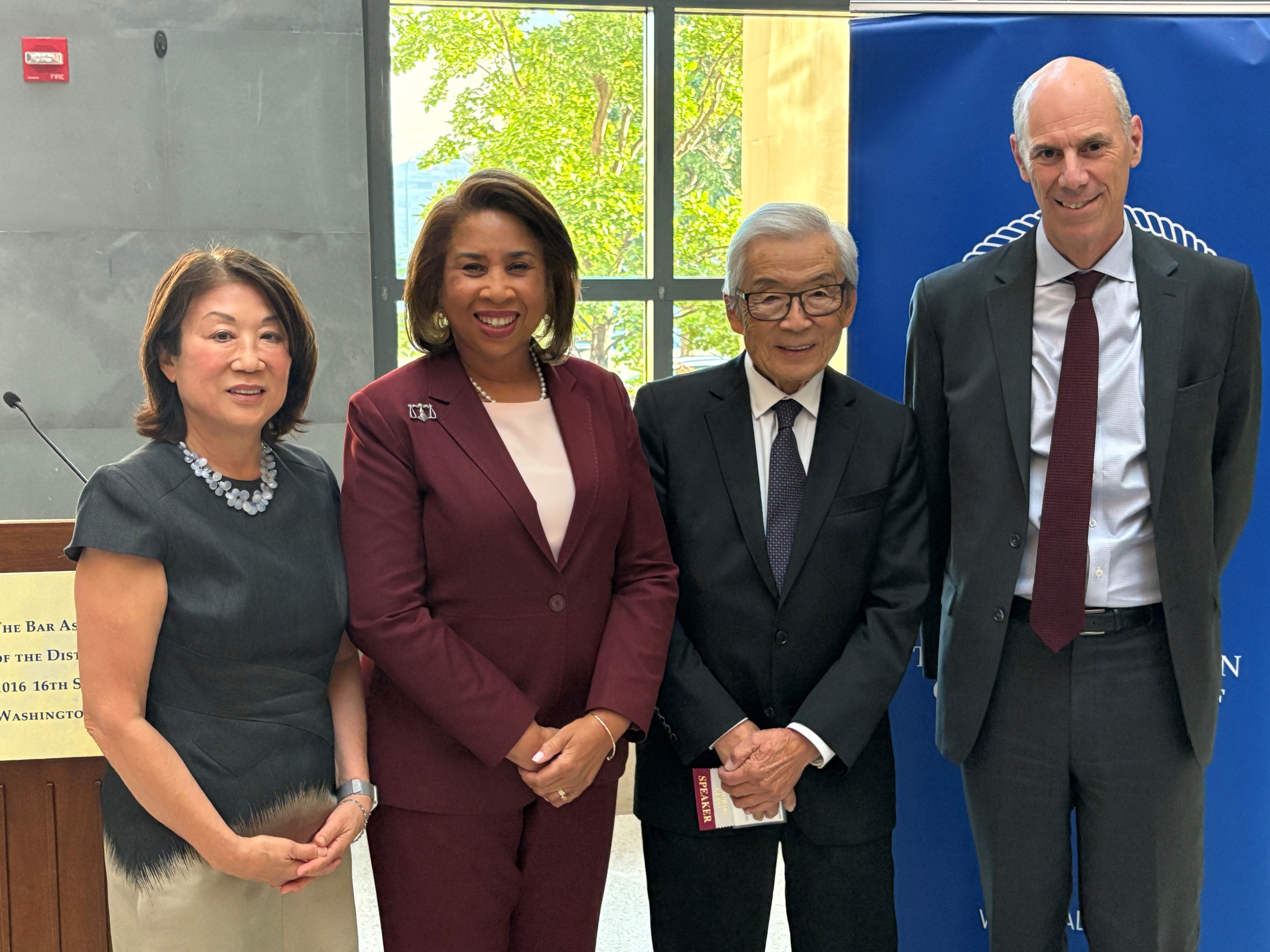Legal Happenings
At BADC Judicial Reception, Attendees Reflect on Lessons Learned From Japanese American Incarceration During World War II
October 10, 2025
.jpg?width=649&height=487)
From left to right: BADC President Shirley Ann Higuchi, D.C. Court of Appeals Chief Judge Anna Blackburne-Rigsby, history scholar Sam Mihara, and Chief Judge James E. Boasberg of the U.S. District Court for the District of Columbia.
More than 80 years ago, following the attack on Pearl Harbor, Sam Mihara and his family were forcibly removed from their San Franciso home and sent to the Heart Mountain War Relocation Center in Wyoming by the U.S. government without due process.
Speaking at the Bar Association of the District of Columbia’s (BADC) 2025 Judicial Reception at the E. Barrett Prettyman U.S. Courthouse on October 1, Mihara, a noted history scholar and lecturer, gave a sobering account of his time spent in the Heart Mountain internment camp starting when he was nine years old.
Mihara was introduced by Chief Judge James E. Boasberg of the U.S. District Court for the District of Columbia, calling the former “a living reminder … of a time when certain groups of citizens were deemed not sufficiently American and not sufficiently trustworthy to be allowed to live among us.”
“Instead, they had to be deported and incarcerated in assorted prison-like facilities in remote areas of the country. This internment of Japanese Americans remains a stain on our country’s history. And we should not easily forget,” Boasberg added.
In 1941 President Franklin Roosevelt ordered an investigation into Japanese people living in the United States to assess how loyal they were to American interests. “A [separate] FBI investigation showed there was no reason for the removal of Japanese from the West Coast,” Mihara said. “[The FBI] recommended against it.”
Nevertheless, military leaders and politicians advised the president to authorize the military to exclude “any or all persons” from places in the United States designated as “military areas.” That resulted in Roosevelt signing Executive Order 9066, giving the Department of War authority to remove from their homes approximately 120,000 people of Japanese descent.
Mihara recalled the terrible conditions of the Heart Mountain barracks — there was no insulation, no electricity, and no running water. He said the room where he and his three family members lived for three years was 20 square feet. During that time, his father went blind because there were no doctors to care for his glaucoma, and his grandfather died in the camp without treatment for his cancer.
However, the lesson learned from surviving that harrowing experience is what’s most important, Mihara stressed. “We had been removed from our homes in complete violation of the Constitution,” he said. “[The Fifth] Amendment of the Constitution makes it clear that all persons shall not be deprived of liberty and justice. And that’s exactly what the president did.”
“Future presidents of this country need to adhere to the Constitution,” Mihara continued. “I worry about presidents who will ignore [the Constitution] and do things against it. I think that’s where we get into trouble. I preach to all the young people when it comes time to elect leaders of this country: Be sure that they’re faithful to the Constitution because that’s the most important thing that they can do.”
At the beginning of the reception, BADC President Shirley Ann Higuchi mentioned the National Japanese American Memorial on the corner of Louisiana Avenue and D Street, N.W. “When I talked to a lot of judges and lawyers, they didn’t even know that this memorial is here,” Higuchi said. “Essentially 10 American concentration camps are listed there. [It also honors] the patriotism of our young men who were drafted while in prison and served our country during [WWII].”
The BADC annual event also celebrates newly appointed judges as well as those taking senior status or retiring. After Mihara’s remarks, BADC President-Elect Craig Leen, partner at K&L Gates LLP, presented certificates of recognition to Judges John P. Wiese of the U.S. Court of Federal Claims, John R. Fisher of the District of Columbia Court of Appeals, and Jonathan H. Pittman, Anthony C. Epstein, and Alfred S. Irving Jr. of D.C. Superior Court.
Higuchi presented welcoming certificates to judges who were sworn in this past year, including Amir H. Ali, Sparkle L. Sooknanan, and Matthew J. Sharbaugh of the U.S. District Court for the District of Columbia and U.S. Court of Federal Claims Chief Judge Matthew H. Solomson.


